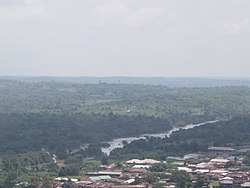Ogun River
6°44′44″N 3°20′33″E / 6.745589°N 3.34259°E
| Ogun River | |
|---|---|
 | |
| Physical characteristics | |
| Mouth | |
• location | Lagos |
• elevation | 0 m (0 ft) |
The Ogun River is a waterway in Nigeria that discharges into the Lagos Lagoon.
Course and usage
The river rises in Oyo State near Shaki at coordinates 8°41′0″N 3°28′0″E / 8.68333°N 3.46667°E and flows through Ogun State into Lagos State.[1] The river is crossed by the Ikere Gorge Dam in the Iseyin local government area of Oyo State. The reservoir capacity is 690 million cubic metres (560,000 acre⋅ft).[2] The reservoir abuts the Old Oyo National Park, providing recreational facilities for tourists, and the river flows through the park.[3] The Ofiki River, which also rises near Shaki, is the Ogun River's chief tributary.[citation needed] The Oyan River, another tributary, is crossed by the Oyan River Dam which supplies water to Abeokuta and Lagos.[4] In densely populated areas the river is used for bathing, washing and drinking. It also serves as a drain for mostly organic wastes from abattoirs located along the river's course.[1]
History
In the Yoruba religion, Yemoja is the divinity of the Ogun River. The catechist Charles Phillips, father of the Charles Phillips who later became Bishop of Ondo, wrote in 1857 that the Ogun River was generally worshipped by the people who live along its banks from its rise until where it empties into the lagoon.[5] The river ran through the heart of the old Oyo Empire. Metropolitan Oyo was divided into six provinces with three on the west side of the Ogun River and three to the river's east.[6] At one time, the river formed an important route for traders carrying goods by canoe between Abeokuta and the Lagos Colony.[7]
References
- ^ a b A.A. Ayoade, A.A. Sowunmi; H.I. Nwachukwu (2004). "Gill asymmetry in Labeo ogunensis from Ogun river, Southwest Nigeria" (PDF). Rev. Biol. Trop. 52 (1): 171–175.
{{cite journal}}: Unknown parameter|lastauthoramp=ignored (|name-list-style=suggested) (help) - ^ L. Berga, ed. (2006). Dams and Reservoirs, Societies and Environment in the 21st Century: Proceedings of the International Symposium on Dams in the Societies of the 21st Century, 22nd International Congress on Large Dams (ICOLD), Barcelona, Spain, 18 June 2006. Taylor & Francis. p. 314. ISBN 0-415-40423-1.
- ^ "Old Oyo National Park". Nigeria National Park Service. Retrieved 5 November 2010.
- ^ Ikenweirwe, N.b., Otubusin, S.O. and Oyatogun, M.O.O. (March 2007). "Fisheries of Oyan Lake, South West Nigeria and Potential for Ecotourism Development" (PDF). European Journal of Scientific Research Vol 16 No 3. Retrieved 22 May 2010.
{{cite web}}: CS1 maint: multiple names: authors list (link) - ^ McKenzie, Peter Rutherford (1997). Hail Orisha!: a phenomenology of a West African religion in the mid-nineteenth century. BRILL. p. 30. ISBN 90-04-10942-0.
{{cite book}}: Invalid|ref=harv(help) - ^ Stride, G.T.; C. Ifeka (1971). Peoples and Empires of West Africa: West Africa in History 1000-1800. Edinburgh: Nelson. p. 296. ISBN 0-17-511448-X.
{{cite book}}: Unknown parameter|lastauthoramp=ignored (|name-list-style=suggested) (help) - ^ Foreign and Commonwealth Office (1859). British and foreign state papers, Volume 54. H.M.S.O.
